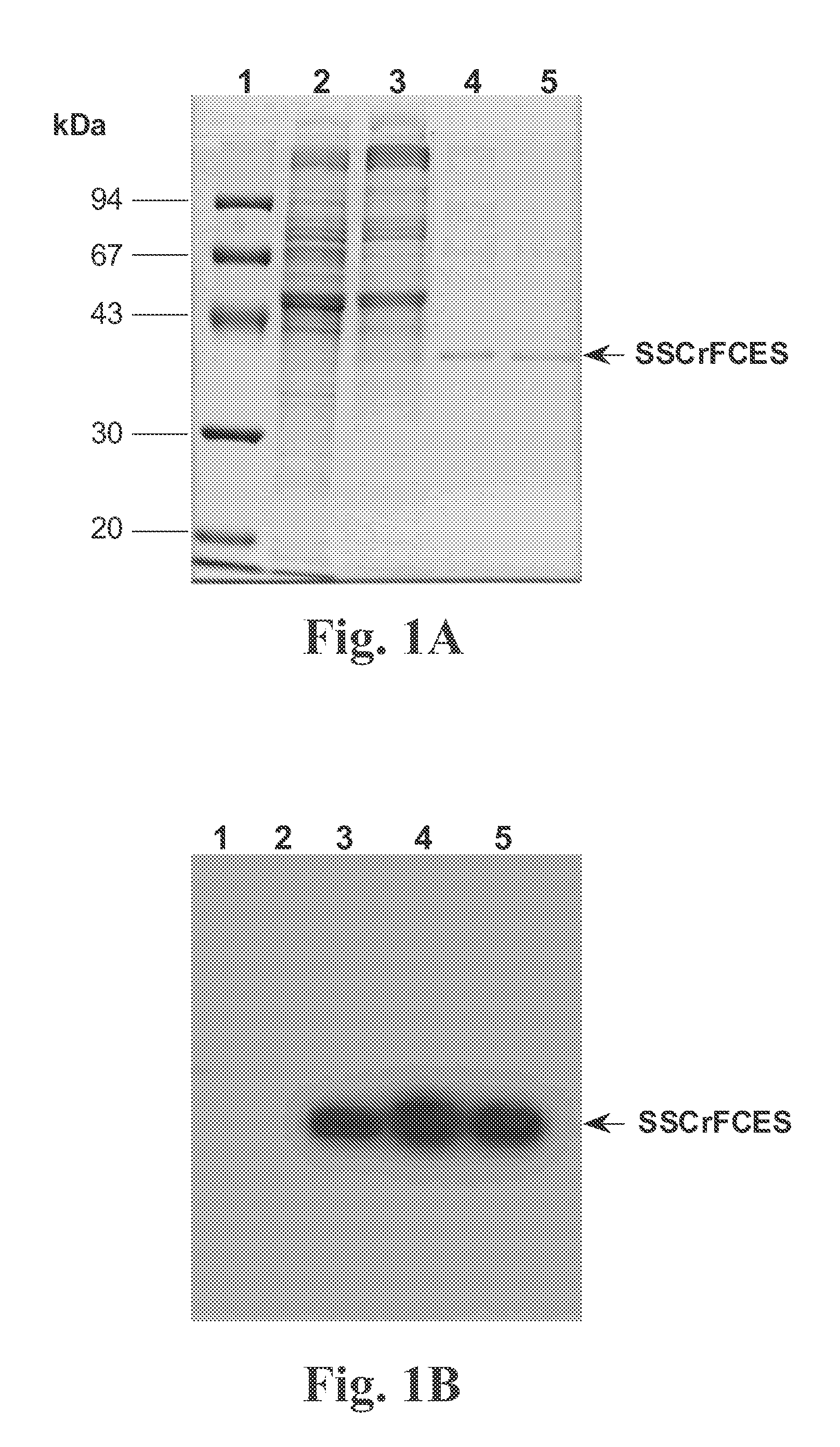Factor c for treating gram-negative bacterial infection
a gram-negative bacteria and factor c technology, applied in the field of recombinant polypeptides and synthetic peptides, can solve the problems of lps-induced cytokines and a large difficulty in doing so, and achieve the effect of suppressing lps-induced cytokines and strong antimicrobial potencies
- Summary
- Abstract
- Description
- Claims
- Application Information
AI Technical Summary
Benefits of technology
Problems solved by technology
Method used
Image
Examples
example 1
Purification of Stably Expressed and Secreted Recombinant SSCrFCES
[0086] Stable cell lines of Drosophila S2 clones expressing SSCrFCES (U.S. Pat. No. 6,733,997) were routinely cultured in serum-free DES Expression medium and maintained at 25° C. in a humidified incubator.
(a) Purification of SSCrFCES Using a Talon Column
[0087] The medium containing SSCrFCES was initially concentrated and desalted via 3 rounds of ultrafiltration using a 10 kDa cutoff membrane in an Amicon stirred cell (Millipore). Affinity chromatography purification under denaturing conditions yielded a 38 kDa protein of interest, in addition to a 67 kDa protein. Western blot analysis indicated that the 67 kDa protein does not contain the carboxyl poly-His tag. Thus this larger protein is likely due to non-specific adsorption to the resin.
(b) Purification of SSCrFCES by Preparative Isoelectric Membrane Electrophoresis
[0088] Typically, 2 liters of conditioned medium were initially subjected to successive ultraf...
example 2
ELISA-Based Lipid A Binding Assay
[0092] A Polysorp™ 96-well plate (Nunc) was first coated with 100 μL per well of various concentrations of lipid A diluted in pyrogen-free PBS. The plate was sealed and allowed to incubate overnight at room temperature. The wells were aspirated and washed 6 times with 200 μL per wash solution (PBS containing 0.01% Tween-20 and 0.01% thimerosal). Blocking of unoccupied sites was achieved using wash solution containing 0.2% BSA for 1 hour at room temperature. Subsequently, blocking solution was removed and the wells washed as described above. Varying concentrations of SSCrFCES were allowed to interact with bound lipid A at room temperature for 2 hours.
[0093] Bound SSCrFCES was detected by sequential incubation with rabbit anti-SSCrFCES antibody (1:1000 dilution) and goat anti-rabbit antibody conjugated with HRP (1:2000 dilution) (Dako). Incubation with each antibody was for 1 h at 37° C. with washing between incubations as described above. In the fin...
example 3
Surface Plasmon Resonance (SPR) Studies on Biospecific Binding Kinetics Between Lipid A and: CrFCES; SSCrFCsushi-1,2,3-GFP; SSCrFCsushi-1-GFP; SSCrFCsushi-3-GFP; and Synthetic Peptides
[0097] Recognition of lipid A by the abovenamed secreted recombinant proteins and peptides was performed with a BIAcore X™ biosensor instrument and an HPA sensor chip. Briefly, lipid A at 0.5 mg / ml in PBS was immobilized to a HPA sensor chip (Pharmacia) according to the manufacturer's specification. In all experiments, pyrogen-free PBS was used as the running buffer at a flow rate of 10 μL / min.
[0098] With purified SSCrFCES, 4 μg / ml was injected into the flow cell at a rate of 10 μL / min, and the binding response was measured as a function of time. Following injection of SSCrFCES, a solution of INDIA™ H is Probe T-HRP antibody, diluted in PBS to 400 μg / ml, was also injected to cause a shift in SPR in order to further confirm that SSCrFCES binds to lipid A. For regeneration, 100 mM of NaOH solution was ...
PUM
| Property | Measurement | Unit |
|---|---|---|
| molar ratio | aaaaa | aaaaa |
| molar ratio | aaaaa | aaaaa |
| flow rate | aaaaa | aaaaa |
Abstract
Description
Claims
Application Information
 Login to View More
Login to View More - R&D
- Intellectual Property
- Life Sciences
- Materials
- Tech Scout
- Unparalleled Data Quality
- Higher Quality Content
- 60% Fewer Hallucinations
Browse by: Latest US Patents, China's latest patents, Technical Efficacy Thesaurus, Application Domain, Technology Topic, Popular Technical Reports.
© 2025 PatSnap. All rights reserved.Legal|Privacy policy|Modern Slavery Act Transparency Statement|Sitemap|About US| Contact US: help@patsnap.com



